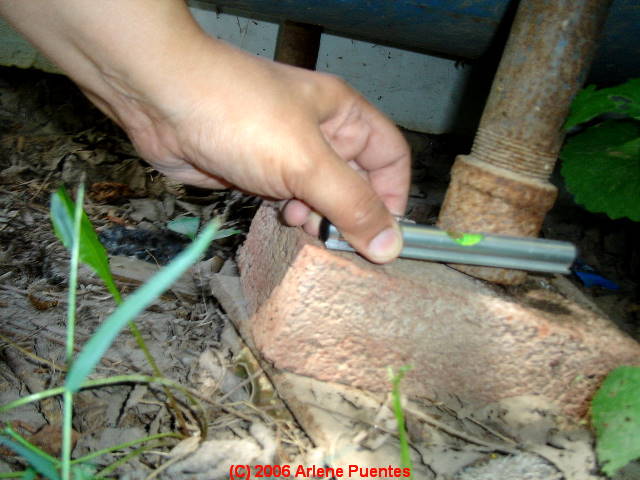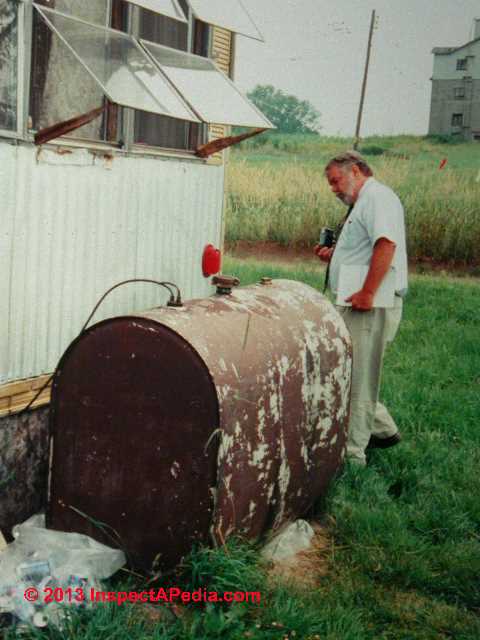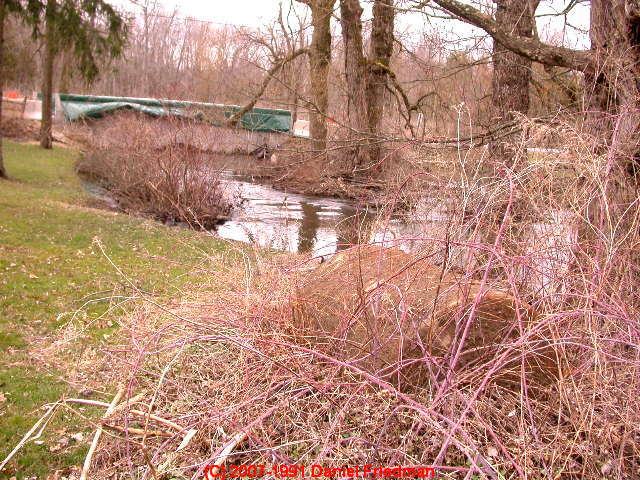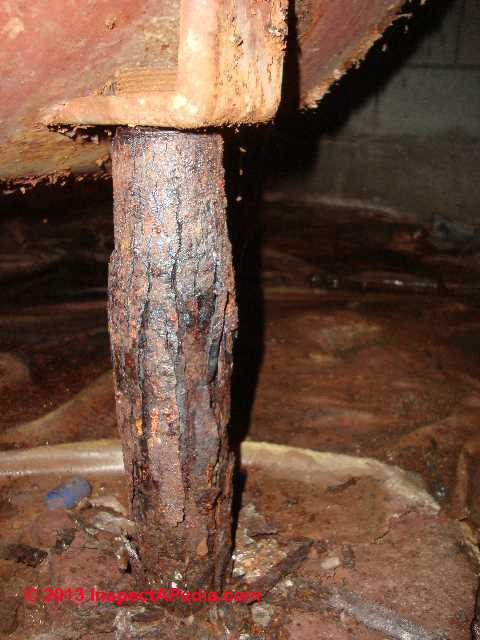 Check Oil Tank Legs, Feet & Piers
Check Oil Tank Legs, Feet & Piers
Rusty or tipped oil tank support legs or piers risk an oil spill
- POST a QUESTION or COMMENT about oil tank support requirements:legs, feet, piers
This article discusses inspection of oil tank support and piers.
The article and photographs give advice and examples guiding the visual inspection of above ground oil tanks for leaks and damage.
The photo above shows an oil tank supporting leg (commonly made of iron pipe) that has been so exposed to flooding that it is badly rusted and about to split and collapse.
If the pier or foot supporting an oil tank collapses, tips or slips and the oil tank falls over, a costly oil leak as well as possible damage from loss of heat to the building could be the result.
Page top photo provided by Arlene Puentes.
InspectAPedia tolerates no conflicts of interest. We have no relationship with advertisers, products, or services discussed at this website.
- Daniel Friedman, Publisher/Editor/Author - See WHO ARE WE?
Oil Storage Tank Support Requirements: feet, legs, piers, strapping, impact protection
Two worrisome hazards in the supporting legs or "feet" for an oil tank are shown at page top - rusty legs or feet about to collapse - and just above - an oil tank leg sitting on a pier so tipped that the whole tank is likely to tip over, spilling heating oil and causing the building to lose heat as well.
Article Contents
- OIL TANK SUPPORT LEGS & PIERS DEFECTS
- OIL TANK PROTECTION from VEHICLES or from TIPPING OVER - strapping? balusters?
- OIL TANK SUPPORT & PROTECTION CODE
Depending on where an above ground oil tank is installed, local climate, wind or flooding exposure, an oil tank may also need strapping or other anchoring protection to prevent wind uplift or flood damage and floating away.
...
Oil Tank Leg or Pier Inspection Points
Here are two key indicators problems with the support of an oil storage tank that any home owner or home inspector can examine as long as the tank is visible and accessible in or at a building.
Are the tank support legs sound and on firm footing? A standard 275-gallon tank with an average capacity of 260 gallons weighs about 2000 lbs. Placed on wood or dirt the tank is likely to tip and spill.
If required by local ordnance, is other tank support in place?
The photo shows a seriously tipping oil tank support pier, risking tipping of the tank, oil spillage, loss of heat (risking frozen pipes and water or mold damage) and environmental contamination.
That tiny line level is being held in an approximately level position so that you can see that in less than three inches the support for this oil tank foot is tipped by nearly an inch: risking a tipped-over oil tank and an oil spill disaster.
Photo courtesy Arlene Puentes, Kingston NY
What about rusty oil tank feet? The rust shown in the photo just above is trivial in that it has not caused enough damage that we have any concern that the tank is going to tip over - at least not in the near future.
Compare that with the collapsing rusty oil tank leg at the top of this page.
But rust on oil tank supporting feet for an indoor oil storage tank, especially on those back feet close to the wall, hard to reach, and hard to re-paint, are a great indicator of the history of water entry in a building.
What about just skipping oil tank feet entirely. Why can't we just sit the oil tank on the ground?
Steve Vermilye (photo at left) looked concerned for a reason. This oil storage tank had not much besides luck holding it up, and in addition, the tank was not designed for ground-contact.
This oil tank installation is inviting rust perforation of the oil tank or a tipped-over oil tank spill and loss of heat all at once.
...
Oil Tank Protection From Vehicles or from Tipping-over
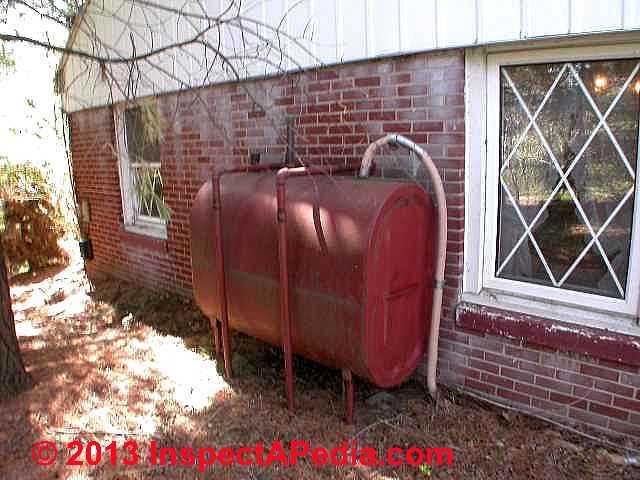
Regardless of whether an oil tank is installed indoors or outdoors above ground, it must be properly supported.
Some municipalities also require installation of special protection to assure that a tank cannot tip over, even if its feet are damaged.
A steel pipe may be installed in the floor next to the tank and extended vertically above the tank and then after making a 90 deg. bend, secured to the wall to "cage" the oil tank.
Our photo (left) shows steel piping installed to protect an outdoor oil tank from tipping over.
Where oil tanks are installed in garages, some jurisdictions require that the garage oil tank (and boiler or furnace if one is present) also be protected from being struck by a vehicle using similar iron pipe guards as just cited above.
See PROTECTION BOLLARDS for MECHANICAL EQUIPMENT
Also see additional visibly detectable oil tank defects listed
at Home Inspection Report Language Library: Visible Defects in Oil Tank Installations, Tanks, and Heating Oil Piping.
...
NFPA & Other Standards: requirements for support and anchoring of oil tanks
Photo: this buried oil storage tank, not secured, floated up out of the ground when this property in Rhinebeck, New York was subjected to flooding.
- PLASTIC OIL TANKS 5-YEAR INSPECTION PLAN NYS DEC [PDF] (2007), NYS DEC, Five-Year Inspection of Plastic Tanks (DER-16), DEC Program Policy [PDF] (2007) New York State Department of Environmental Conservation, retrieved 2021/06/27 original source: https://www.dec.ny.gov/regulations/38102.html
Excerpt:
[Buried Oil Tank Anchors] "b. Foundations & Supports
Only properly graded and leveled surfaces having adequate physical characteristics shall be used for foundations. Tank anchors should be installed to allow for the tank expansion/flexure; improperly installed anchors may initiate cracks in the tank.
Flat bottomed tanks should only be installed on a smooth, flat base.
Manufacturers typically specify a deviation from nominal level depending on the tank size. Care must be taken to ensure that the base is free of debris. All installations shall follow manufacturer's specifications where available.
Where wind-loading calculations require the use of tie-down bolts, these must be correctly installed using the brackets or steel girdle attached to the tank.
All of the requirements of 6 NYCRR section 598.3 must be followed when tanks are installed within a flood plain." - NFPA 31 mentions "API Standard 650, Specifications for Welded Steel Tanks for
Oil Storage", from the American Petroleum Institute, for guidance on SEISMIC protection for installation of above-ground tanks.
It also addresses wind load on tanks, and raises awareness of "sloshing" and resulting "uplift" of supports, which could result in shifting and collapse.
- Similarly, like outside propane tanks, oil tanks in areas subject to FLOODING must be properly secured to prevent them from floating away, rupturing the pipes. - 2 Feb 2015 NHFireBear - a building code expert who has frequently contributed to InspectApedia.
...
Continue reading at OIL TANK INSPECTION & TROUBLESHOOTING or select a topic from the closely-related articles below, or see the complete ARTICLE INDEX.
Or see these
Recommended Articles
- OIL TANK INSPECTION & TROUBLESHOOTING - home
- OIL or SEPTIC TANKS FLOATING UP - rising flood waters carry off the tank
- OIL TANK SLOPE to AVOID SLUDGE PROBLEMS
- PROTECTION BOLLARDS for MECHANICAL EQUIPMENT - when do we need bollards to protect an oil tank?
Suggested citation for this web page
OIL TANK SUPPORT at InspectApedia.com - online encyclopedia of building & environmental inspection, testing, diagnosis, repair, & problem prevention advice.
Or see this
INDEX to RELATED ARTICLES: ARTICLE INDEX to HEATING OIL, OIL BURNERS, OIL FIRED HEATERS, OIL TANKS
Or use the SEARCH BOX found below to Ask a Question or Search InspectApedia
Ask a Question or Search InspectApedia
Try the search box just below, or if you prefer, post a question or comment in the Comments box below and we will respond promptly.
Search the InspectApedia website
Note: appearance of your Comment below may be delayed: if your comment contains an image, photograph, web link, or text that looks to the software as if it might be a web link, your posting will appear after it has been approved by a moderator. Apologies for the delay.
Only one image can be added per comment but you can post as many comments, and therefore images, as you like.
You will not receive a notification when a response to your question has been posted.
Please bookmark this page to make it easy for you to check back for our response.
IF above you see "Comment Form is loading comments..." then COMMENT BOX - countable.ca / bawkbox.com IS NOT WORKING.
In any case you are welcome to send an email directly to us at InspectApedia.com at editor@inspectApedia.com
We'll reply to you directly. Please help us help you by noting, in your email, the URL of the InspectApedia page where you wanted to comment.
Citations & References
In addition to any citations in the article above, a full list is available on request.
- In addition to citations & references found in this article, see the research citations given at the end of the related articles found at our suggested
CONTINUE READING or RECOMMENDED ARTICLES.
- Carson, Dunlop & Associates Ltd., 120 Carlton Street Suite 407, Toronto ON M5A 4K2. Tel: (416) 964-9415 1-800-268-7070 Email: info@carsondunlop.com. Alan Carson is a past president of ASHI, the American Society of Home Inspectors.
Thanks to Alan Carson and Bob Dunlop, for permission for InspectAPedia to use text excerpts from The HOME REFERENCE BOOK - the Encyclopedia of Homes and to use illustrations from The ILLUSTRATED HOME .
Carson Dunlop Associates provides extensive home inspection education and report writing material. In gratitude we provide links to tsome Carson Dunlop Associates products and services.


